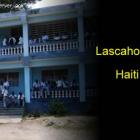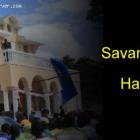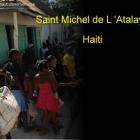ADVERTISEMENT
Energy Environment
The environment of Haiti is faced with huge problem. The total forest cover was approximately 2% in a country where 75% of energy demands were satisfied by wood fuel, and a lack of trees had in turn caused significant soil erosion.
Haiti Accord with Convention on Biological Diversity to Improve and Maintain Natural Resources
The Caribbean contains a high level of biodiversity at risk of further degradation. The Caribbean Biological Corridor (CBC) has been set up to facilitate cooperation between Caribbean countries to engage in biodiversity restoration and sustainability practices used world-wide. The CBC is comprised of three nations. Haiti and the Dominican Republic, sharing the island of Hispaniola, and Cuba, lying to the north, are subject to frequent natural disasters. These events weaken biodiversity infrastructure and scare off organizations that worry increases in expenditures will bankrupt their efforts.
Haiti ranks second in natural-resource differentiation with over 30% flora and 75% vertebrates native and omnipresent on the island. Despite these impressive statistics, its tree-canopy coverage has been severely depleted, with only 1.5% of Haiti's landmass blanketed.
Bill Clinton and Richard Branson to Launch Haiti Forest Initiative
The Clinton Foundation, Virgin Unite and Yunus Social Business have teamed up to re-forest Haiti. The three entity's, backed by three of the world's most influential men, former US President Bill Clinton, billionaire Richard Branson and microfinance creator and peace prize winner Mohammed Yunus, seek not just to replant what has been lost over the past 500 years, but to provide employment, timber, and food while creating a model for programs that can bring positive change to the country. The initiative, called Haiti Forest, has the promise of ten thousand hectares of land from the Agriculture and Environment Ministries in the Artibonite and northern regions of Haiti, and is said to be a Social Business, promoting social benefit over privatized profiteering.
Energy Saving Tips for this Hot Summer
Summer 2013 could perhaps have some of the highest temperatures ever recorded. For most, this means a higher energy bill.
Conserving on your energy bill will end up saving you big, especially leading up to 2013's summer scorcher.
With A/C:
• Ensure your unit fits snugly in its window and there are no openings for precious cool air to escape. Cool rooms only when they are occupied (same goes for using the lights and appliances) and close off unused sections by shutting doors. This heat boundary can save you up to 20% on your bill. Also, keep your filters clean and service your unit annually.
• Block out the sun by closing curtains or shades. During the hottest parts of the day, the sun's penetrating rays kick a/c units into overdrive. Stave off this effect by blocking some of the light. Investing in trees that will grow to provide shade at easterly and westerly points is a good, long-term idea.
•
Without A/C:
• Unplug appliances that aren't being used. That red light on your TV, radio, DVD player or cell phone charger (which uses the same amount of energy in use or dormant) sucks power even when you're not looking! Keeping your plugs on one unit means it's easy to unplug whole sections not being used at once.
• Taking cold showers is not just practical in the heat, it is energy efficient too.
• Give your oven a break; they have a tendency to heat up the whole house, which in turn inspires energy usage for cooling down.
• Use energy saving bulbs.
Finally, go out and enjoy the summer at the beach or somewhere cool. Your electricity bill will miss you, but... what to do?
As source Kaara decreases, Saut d'Eau may no longer exist
Saut-d'Eau falls in the Central Plateau of Haiti is at peril of running dry. Its mouth, Kaara, is not producing enough water to keep the waterfall of Saut-d'Eau at full volume, having declined in its output over the last six months.
Simon Desras, President of the Senate, worries if the falls should stop flowing, the economy of the Central Plateau will suffer. The stoppage would damage, not only the economy of the region, but affect a tradition that has taken place at the falls since 1847. In that year, an apparition of the Virgin Mary manifested at the twin falls, beginning an annual pilgrimage to Saut-d'Eau, to bathe beneath the onrushing streams that plunge down the gorge. Upwards of 20,000 bathers visit each year for this sacred rite.
Pic Macaya's Potential for Eco-Tourism
Haiti seduces all visitors to the island with her tropical and cultural splendor. Her history is steeped in royal rulers, an intoxicating racial heritage, vibrant, indigenous art, and the compelling rituals of Voodoo-ism.
Since the 2010 earthquake ruined the country's infrastructure, one of the strategies to rejuvenate it has been eco-tourism. The global green movement has been encouraging conservationists to invest in natural resources to keep eco-systems healthy and thriving. And also to attract revenues which contribute to economic growth.
Haiti's neighbor, the Dominican Republic (DR), has become enriched on revenues coming from eco-tourism. Haiti's wealth of untapped natural resources is a prime candidate for eco-tourism development also. Sharing the island of Hispaniola's abundant eco-systems with the DR, it is only a matter of targeting which resources have potential for significant revenue-growth to attract private investment.
Minister of Agriculture, Thomas Jacques, monitoring work at Riviere Grise
Departmental Director of the West, Mr. Arnoux Severin and Minister of Agriculture, Mr. Thomas Jacques together went on a monitoring survey of the gabionade and clearing works in Rivière Grise. The purpose of the visit by the two Agricultural Engineers was to monitor the work progress.
The overall project has an estimated cost of 62 million gourdes which will come from the state government treasury. The work spans over an area of length 6.3 km. This project will go through three major bridges which include Tabarre Bridge, Croix-des-Missions Bridge and Duvivier Bridge. The work will end at Duvivier Bridge. The Duvivier Bridge is located in the Cité Soleil town. The estimated time frame for the entire work has been calculated to be 3 months.
Haiti among the top countries in Unpaid Electricity Consumption
The public utility company in Haiti, Electricite d'Haiti (EDH) is largely owned by the Haitian government. It is also a symbol of Government inefficiency in providing needed services for its people.
In Haiti, only 12.5% of the population has access to electricity, officially. This however does not explain the real story. Irregular connection or to put it more direct, "stolen Electricity" accounts for more than 25% of the public consumption of electricity in the country.
Electricite d'Haïti (EDH) estimates that about 35% of distributed power is not being paid for by the public. Many residents in poor neighborhoods who can't afford the high cost charged by the company resort to stealing electricity. That is possible because the government is unable to enforce the laws, preventing people from stealing electricity.
Plan for Reliable, Cost-efficient and Clean Energy to DR and Haiti
Plans for a substantial investment by the International Finance Corporation (IFC), geared towards creating power solutions for Haiti and the Dominican Republic, were recently announced. The World Bank Group member, in tandem with their African, Latin American and Caribbean Fund (IFC ALAC) will help InterEnergy Holdings (IEH), a leading private investor in the propagation of power in Haiti's neighbor country, with interests in the power sector of the region, to create energy that is more efficacious in its productivity while leaving a smaller carbon footprint.
The $100 million endowment is an equity investment towards developing cleaner energy sources within the Caribbean, with plans of expansion into Latin American territories. The Dominican Republic has already made plans to cut down their emissions by 25% in time for 2030, and, already a proponent of the 'clean bill', Haiti's per capita carbon emissions is less than 185 other countries, at less than 0.1%.
Haiti's Unchecked Deforestation Affects Top-Soil Conditions
Haiti is a small island of 10 million inhabitants, which shares Hispaniola with its eastern neighbor, the Dominican Republic. The smaller of the two countries, it takes up roughly the size of the state of Maryland. Due to deforestation, the country is vulnerable to frequent hurricanes and extreme tropical storms five months out of the year. In addition, the land has been subject to rampant deforestation among other environmental threats.
The island was once home to uninhabited forests that spread throughout the land. But over decades of cross-cutting and -clearing, the forests have been razed and only 4% of the original land mass remains. Because Haiti's topography is mainly hilly and mountain-covered, the nearly-vertical hillsides suffer top-soil erosion, between one and one-and-a-half tons annually. Because there are no trees to absorb the rainfall, top-soil is sloughed off.
Haiti Eco-System Virtually Worst in the World
The country of Haiti is heir to many challenges besetting the island since it won its independence in 1804. Not only has she endured frequent upheavals in her governing body, wide-spread poverty, and illiteracy, the environment has been deteriorating since the 1980s. The non-government organization (NGO), Agency for International Development (AID), has released an update on the state of Haiti's environment, detailing the amount of damage its ecological infrastructure has sustained.
Once a place of untouched forestland blanketing all of the terrain, forests now account for only 4% of the entire land mass. UN investigators estimate forest reduction at a rate of 3% annually. With so much exposed topsoil and heavy seasonal rainfall, the ground cover is sloughed off, more than one-and-a-third tons for each square half-mile.
Our objective is to share with you news and information about Haiti and the people of Haiti. Traditions, habits and the way we were or grew are alive in this site. We highly recommend that you Subscribe to our Newsletter and also share with us some of the things that are memorable and made us unique people.

 Lascahobas, Haiti
Lascahobas, Haiti  Newsletter
Newsletter  The Town of Savanette, Haiti
The Town of Savanette, Haiti  Saint Michel de L 'Atalaye
Saint Michel de L 'Atalaye  Life After Death
Life After Death